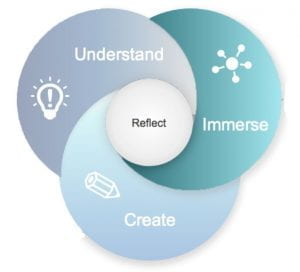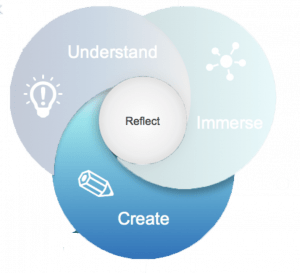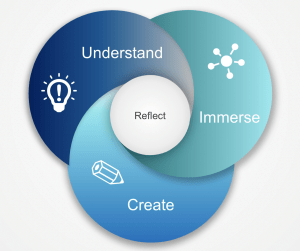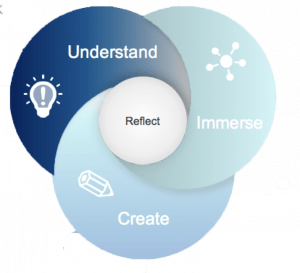The St Luke’s Inquiry Process
The St Luke’s Inquiry Process
Our inquiry process at St Lukes was designed in order to ensure that there was a consistency of understanding of what inquiry looked like from K-12. In this case, it needed to be simple, with easy to understand elements for students (and teachers), with the flexibility to work differently for more experienced teachers in inquiry. The model that we’ve used is adapted from research into many different inquiry learning models around the world.
The process starts at understanding the problem, immersing students in skills, knowledge and capabilities, in order to create something (whether this be an essay, a physical project, a poem). Reflection sits in the center of all of this, as reflection sometimes sees a student moving around and in and out of the cycle at different rates and pathways based on the student, the KLA and the specific piece of learning that they are doing. Learning should be based around whatever is at the best interest of that student at that point of time based on the particular thing that they are meant to learn.
Understand
Understanding process includes the engagement and unpacking of what is required by the problem.
This includes an entry event where teachers open the idea of the unit of work to students. For example, in the unit of work on Forces and motion, students played games that involved different types of motion in groups, rating each game and noting any different types of motion that they utilised.
Students then watched the OK Go Rube Golberg video to look at possibilities for their Rube Golberg Machine.
Students then construct as a class a Need to Know list, which elicits pre-existing knowledge and questions that students may have about the project.
Students then, under the guidance of their teacher, immerse themselves in activities that guide their further understanding of knowledge and skills necessary to build further questions to explore. For example, prior to developing their Rube Golberg machine, students will need to do some research on different types of forces, and the different types of machines that can generate these forces. However, students that have no understanding of what a force is, cannot guide their own inquiry during the information gathering process. Therefore, this process is intended to immerse and engage the students in their needs to know.
SOL Staff’s thoughts about what might go in this section:
- Brainstorm
- Entry document/event
- Get data and information
- Unpack the problem
- Knows and need to know.
Immerse
Within the Information gathering process, students gather skills and knowledge through experiences and workshops designed and guided by their teachers.This knowledge and skills acquisition process is guided by the needs to know with students identifying the need to know something, students then further exploring and then gathering and refining the information that they need to know to construct their end product or answer the question.
For example, in the Rube Goldberg project, students conduct a number of different science experiments in order to gather knowledge and understanding about different forces. Students then undergo small practical activities in order to understand the concepts of forces. Students should have choice integrated into what they are doing…choice around what to research, how to apply that knowledge, so long as it meets the outcomes of the course.
SOL Staff’s thoughts about what might go in this section:
- Facts, Knowledge, data
- Content
- Authentic connections: Immerse, connect, understand
- Note-taking
- Effective Research skills: Key/Main idea/Summary
- Technical skills
- Processes
- Workshops
- Group work
- Modelling
- Demonstration
- GRR
- Benchmarking
- Scaffolding
- Exemplars of work/Blogs
- Plus/Minus/Next steps (peer assessment
- Goal setting
- Self assessment and teacher feedback and peer feedback
 Create
Create
Students within the make/create process are constructing the object. This may be a written activity or a creative activity that requires students to demonstrate their achievement of outcomes. This requires a heavy focus on draft-construct-share as a process of developing prototypes and drafts in order to improve through reflection and feedback. Finally, presentation of their final product, to ensure that students can see that there is an authentic use where the culmination of their learning has a purpose.
A note about the process…
This process is not step by step. The process has reflection as the centre as during the process of learning, students are asked to regularly reflect on their process.
Assessment of outcomes for subjects and pillars are based around students selecting components of work across the project that exemplify their achievement in this outcome. Each outcome is linked to a pillar, with cross-kla outcomes being mapped in order to ensure that students can submit examples of work for multiple outcomes and pillars across different programs.
Eg, in the Rube Golberg, students are required to: WS8 selects and uses appropriate strategies, understanding and skills to produce creative and plausible solutions to identified problems (Science outcome) and 4.5.1 applies management processes to successfully complete design projects (TAS outcomes) both of which requires them to work collaboratively (pillar) and manage themselves (pillar)
SOL Staff’s thoughts about what might go in this section:
- Problem solving
- Experimentation
- Testing
- Refining
- Evaluate, retesting,
- Use feedback effectively to improve product
- Prototyping: Draft, sketch, design
- Teacher created samples
- Student choice
The option to start at different points on the diagram, and to delve back into previous areas based on need, is provided for through the arrows that link backwards and forwards in each element. Teachers may guide students through the understand segment, to information gathering, and then back to further understanding based on their information gathering. Teachers may also start with creation of prototypes in order to fully understand the problem, and then work through the process in a different direction. Central to all is reflection.
SOL Staff’s thoughts about what might go in this section:
- Feedback loop (reflection happens throughout)
- 2 stars and a wish
- Evaluation (qualtrix)
- Maths pathways/education perfect/scribo to get data
- Teacher feedback: Timely and consistent
- Student response to teacher feedback
- Blog
- Critical Friends.

